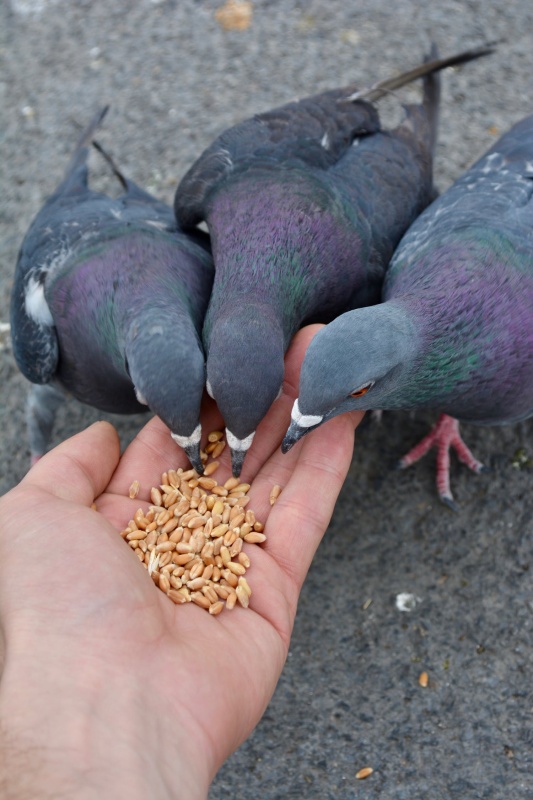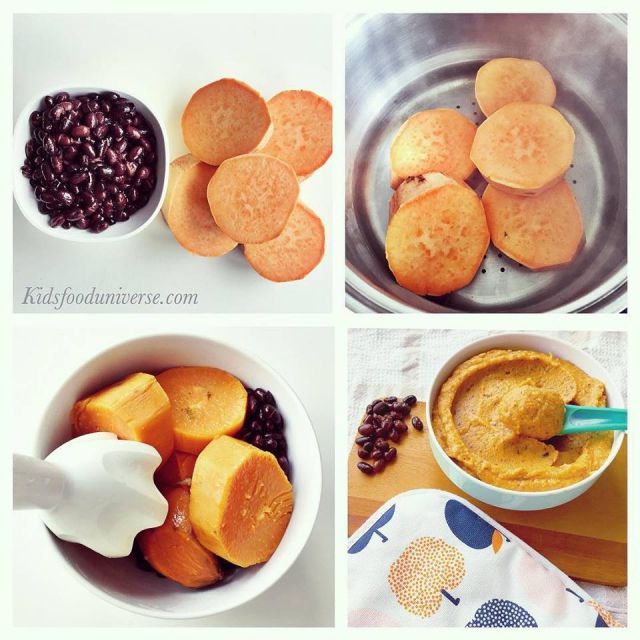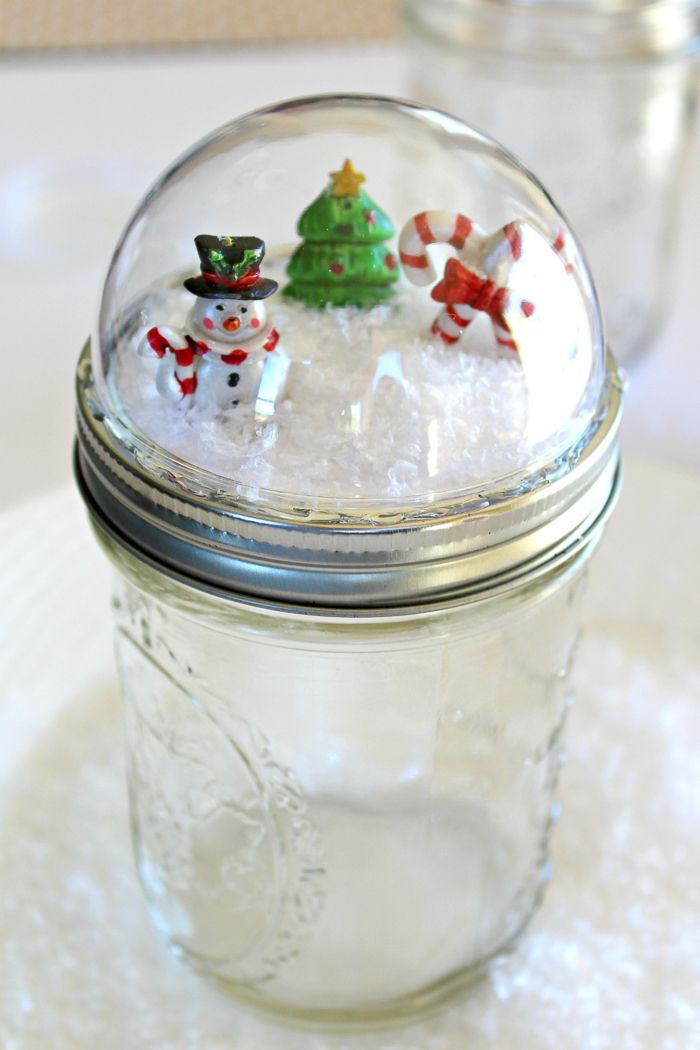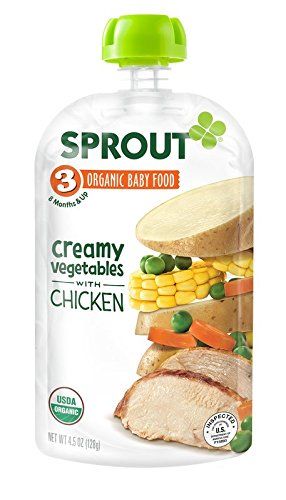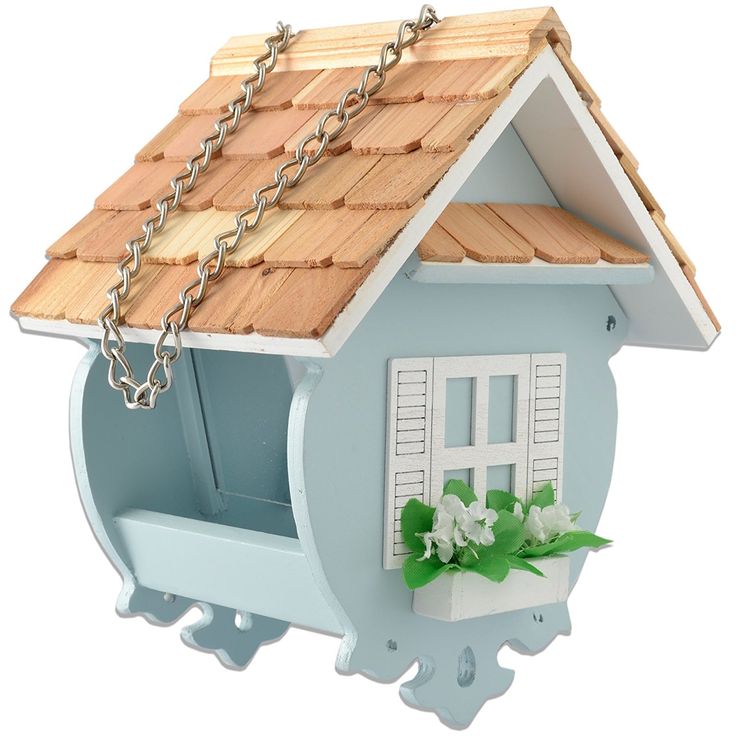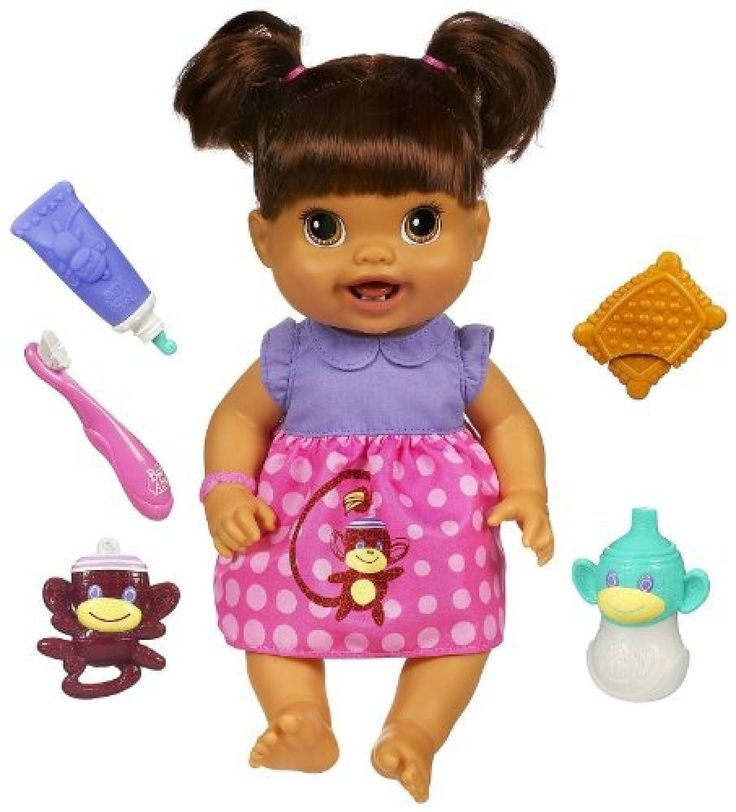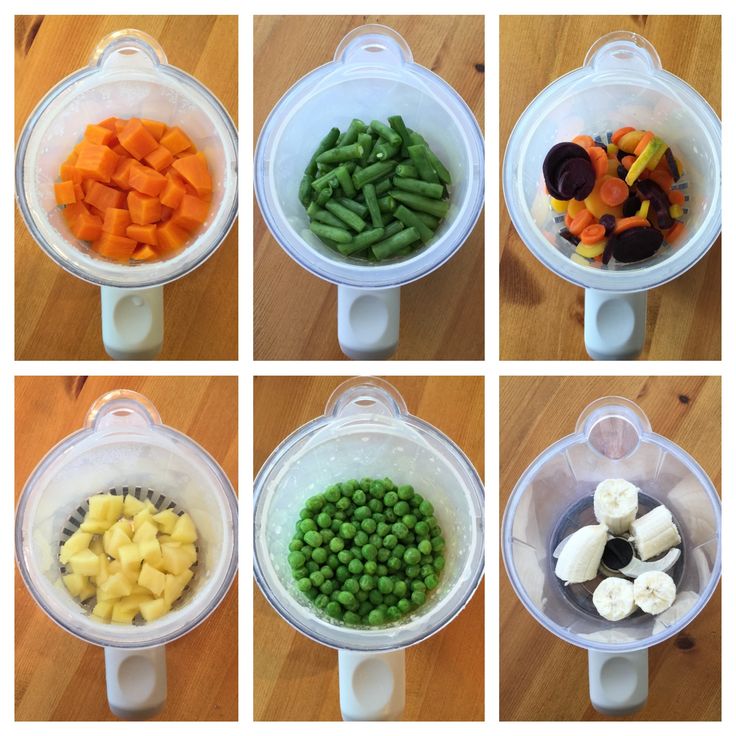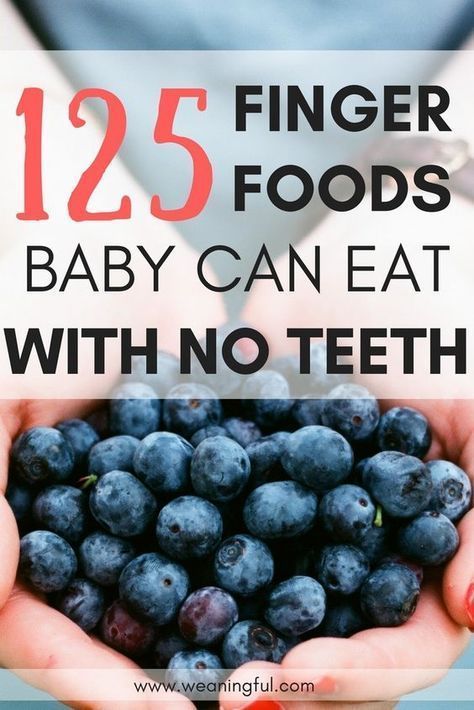How to feed a baby pigeon bird
What Do Baby Pigeons Eat and How to Feed Them Properly
Pigeons may be seen almost anywhere. Although feral pigeons and wood pigeons are typically in towns and cities, little is known about how their babies appear, and what do baby pigeons eat in case you come across a starving one.
Pigeons or doves are wild birds that feed on a variety of foods. Pigeons, whether wild or farmed, usually have the same diet of seeds, small insects, and reptiles. But what about baby birds? Are their foods different from those of the adult pigeon?
This article will give you the answer by going into details about baby pigeons’ food and some tips on baby pigeon care. Mostly, newborn pigeons’ diet depends on crop milk in the first week and crushed foods with low sugar and salt levels later on. You also have to keep the baby warm and prepare a syringe to feed it.
Table of Contents
- How Does a Baby Pigeons Look?
- What Do They Eat?
- What to Feed a Starving Baby Pigeon?
- 1.
Look for newborn birds formula
- 2. Use non-dairy milk (Macadamia milk prefered)
- 3. Use infant cereal without milk powder
- 1.
- How to Feed Baby Pigeons?
- Conclusion
When newly born, pigeon chicks are generally about 5 centimeters long. Their skin is pink or black with a patchy coating of yellow that will later turn into white feathers. Their beak is typically pinkish, sometimes it can be a deeper hue and their feet are in slate grey.
In comparison with the body, their beak, wings, and feet are relatively larger; however, as the chicks grow older, their bodies will develop more evenly. Baby pigeon eyes’ are closed when they are born and not opened until they are four or five days old.
In general, unless you domestically raise pigeons or manage to wander around a pigeon’s nest, you’ll never get to see the chicks in this condition; nevertheless, this is rare because birds nest in high and remote areas. We usually observe baby pigeons once they hit their juvenile age, which is mostly identical to the adult form.
We usually observe baby pigeons once they hit their juvenile age, which is mostly identical to the adult form.
Newborn pigeons less than four weeks old are called squabs, and they are not yet able to fly.
What Do They Eat?Both of the parent birds provide regurgitated crop milk to their newborn pigeons. Crop milk, often known as pigeon milk, is a secretion of the crop lining (a ‘container’ where pigeons store food until digestion). It also contains a lot of proteins and fats. For the first four days, this is regurgitated to the squabs within two hours after hatching.
They will be given crop milk and seeds for the next 5 days. About nine days after hatching, the baby pigeons will be fed an adult meal. This includes fruits, seeds, and invertebrates on occasion.
The food amount provided to young birds grows by the day, especially when seeds or grains are included. During the first week, both parents must feed two newborns. After that, one adult can usually nurse two squabs.
After one week, squabs will be able to eat a variety of food along with its crop milk. Only during the third week do baby pigeons no longer need crop milk and their metabolism can adapt to adult pigeon food.
What to Feed a Starving Baby Pigeon?If you come across a newborn pigeon on the ground, it is better to just leave it alone. It will usually live better without your intervention; if you believe you know better, you generally don’t. If you do believe that there is a problem with a pigeon, please contact a local wildlife rehabilitation facility in your neighborhood.
On the rare occasion you have to raise the baby bird yourself, you should know what and how to feed it. As you do not have their parents’ crop milk, things are more complicated in the first weeks but let’s see how these following tips may help you.
1. Look for newborn birds formulaYou can check out the two popular formulae: Nutribird A21 or Kaytee Extract. These can be easily purchased from pet stores or online. However, ready-made bird formulae may be rather costly. Your local wildlife rehabilitation team may also be able to assist you if the bird is of a wild species.
These can be easily purchased from pet stores or online. However, ready-made bird formulae may be rather costly. Your local wildlife rehabilitation team may also be able to assist you if the bird is of a wild species.
During the first days, you mix the formula with warm water until it looks like skim milk. Then, you can make it consistent like ketchup after 10 days.
2. Use non-dairy milk (Macadamia milk prefered)If you can’t find any baby bird formula or prefer to make the food on your own, you can try non-dairy substitutes like Macadamia milk and blend it following this recipe from The International Dove Society. You will need:
- 71 grams of chicken baby food
- 1 boiled egg yolk
- 15 grams of low-fat yoghurt
- ¼ teaspoon of corn oil
- ¼ diluted vitamin E
- 2 drops of cod-liver oil
- little pinch of vitamin B
- 25 milligrams of vitamin C
- 247 milligrams of calcium carbonate
Put all the ingredients in the blender and mix them up thoroughly. During the first 3 days, you can add a bit of digestive enzymes to the food and wait 30 minutes before feeding the baby. From the second week, you can feed it with seeds, grains, and pigeon foods.
During the first 3 days, you can add a bit of digestive enzymes to the food and wait 30 minutes before feeding the baby. From the second week, you can feed it with seeds, grains, and pigeon foods.
You can use dairy-free baby cereal if you don’t have any options. Mix the cereal with warm water until it reaches skim milk consistency. However, you should only use this if you are in a hurry and the baby is already three to four days old. You should find better alternatives as soon as possible.
Puppy biscuits are another alternative, but they must be soaked in warm water until they are softer.
How to Feed Baby Pigeons?The baby pigeons should be warmed up before feeding. You should put the baby in a box near a 40-watt desk like a reptile bulb. You may also use a low-temperature heating pad or a bottle of hot water but make sure to wrap anything you use in a towel.
When it’s too cold, a newborn pigeon can’t digest the food. Actually, the poor little bird is meant to be brooded over by their parents and kept warm during their first two weeks.
Actually, the poor little bird is meant to be brooded over by their parents and kept warm during their first two weeks.
You should prepare a syringe (with no needle) to pull up the food. First, you need to remove the plunger and wrap the broad end with a self-adhering bandage or dental rubber dam.
Then, use a rubber band to keep it in place and make a hole on it big enough for the baby’s beak. The baby bird will eat from the little hole just like pigeons usually eat from their parents’ mouth. You can gently wipe up any spills on the bird using a warm-water-dipped cotton ear swab.
When the baby is eating, you should keep an eye on its crops to make sure that it consumes enough food. The crop sits directly above the baby’s breastbone and stores food for digestion. If you see the baby regurgitates food, you need to stop because you have overfed it.
Or you can watch for another feeding technique here by AAyan Loft
ConclusionFeeding baby pigeons not only requires knowledge about their special diet but also how to feed them properly. Baby pigeons require adequate nutrition, which primarily includes crop milk. However, you can try alternatives like premade bird meals, the special recipe with MAC milk, or non-dairy infant cereal. Make sure that the food is tender and warm.
I hope you find this article on what do baby pigeons eat helpful, especially when you raise a baby pigeon yourself. If you have any questions or experience with the baby pigeon, feel free to share with us!
Moreover, you also can refer more to other interesting topics of birds:
- Baby mockingbird foods.
- How long can birds go with no food?
- What foods do dodo birds eat?
How to Take Care of a Baby Pigeon Properly – Pigeonpedia
Knowing how to take care of a baby pigeon means understanding each stage of its development and what to feed it, how to feed it, and when.
It means mimicking much of the behavior of wild pigeon parents, including feeding them hatchling formula milk.
As an Amazon Associate I may earn a small fee from qualifying purchases at no extra cost to you. This helps us run the site – thanks for your support!
To properly look after a baby pigeon you will need:
- A heat pad or 40-watt heat lamp
- Pigeon hatchling formula milk
- Plastic feeding syringes
If you’re considering breeding pigeons, understanding how to care for the babies is also pretty important.
Proper care of newborn pigeons ensures their survival and ensures that you are raising healthy birds.
Use this guide to help you along the way.
Understanding Baby Pigeons
Pigeon parents are good at caring for their own babies, but if you’re breeding them or you have one with an inattentive mother, it makes sense to know what you’re up against before getting started.
Before you can care for a baby pigeon, it’s a good idea to have an understanding of what you can expect when they hatch.
Generally, it takes about 18 days for a pigeon to hatch once the mother lays her eggs (pigeons generally lay up to 3 eggs at a time).
If you’ve found an abandoned pigeon egg read our article on how to care for a pigeon egg here.
Unlike many other species of birds, pigeon babies stay in the nest for up to six weeks in some cases.
This means that your baby pigeons will need more care in the nest than other kinds of birds.
You can expect your baby pigeons to look more like adults by the time they are ready to leave the nest. Knowing this helps you make the right care choices for your pet birds.
After Hatching
You might be surprised to learn that hatching is very hard work for a baby pigeon and once it’s free of its shell, it will need to rest for about 12 hours before you need to feed it or do any other kinds of care.
The exception to this is if the baby pigeon is in distress, in which case, it’s probably best to have a veterinarian who is experienced with taking care of baby birds have a look at your pigeon.
Top Tip: If you ever find an abandoned baby pigeon and are wondering how old it is, use our pigeon age chart to work it out.
Keeping Your Baby Pigeon Warm
In general, a baby pigeon will spend the first couple of weeks of its life being brooded by the parent pigeons, so without that parent, it falls on you to keep the baby bird warm.
You won’t need to put them near a fireplace or in direct sunlight.
They will only need a gentle source of warmth, such as a heating pad set on the low level or a 40-watt heating bulb like you might use for a pet lizard.
You might also try a pet snuggle heating pad, which you can find in pet stores, or a water bottle filled with warm water and wrapped in a towel.
Make sure your baby pigeon has access to this heat at all times for the first few weeks of its life.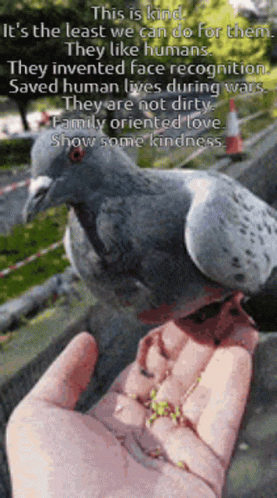
Some experts recommend keeping their area at about 90 degrees. You can line their box or nesting area with newspaper to help hold the heat inside.
What to Feed Your Baby Pigeon
Contrary to what you might have heard, baby birds don’t actually eat worms, nor should you give them dairy milk as you might offer to other baby animals.
These items are not safe for a baby pigeon and won’t provide the nutrients they need to grow.
Foods that aren’t recommended for baby pigeons can make them very sick or even kill them, so it’s vital to make sure your baby pigeon is getting the right things to eat.
Your baby pigeon will likely sleep for the first 12 hours after hatching and you won’t need to feed it during this time.
Once it’s awake, however, you will need to feed your baby pigeon every couple of hours.
If parents are in the picture, they will feed the babies crop milk, which is a partially digested liquid that the baby bird takes directly from the mother or father bird’s mouth.
Therefore, when you feed your baby pigeon, the food will need to be similar in consistency and nutrients.
Fortunately, there are a few ways you can do this.
Look for pigeon hatchling hand-rearing formula products at pet supply stores. You can use this to mimic the crop milk that a parent pigeon might feed its baby.
Keep in mind that you’ll need to gradually thicken the formula and increase the amount you offer as the days go by.
Each kind of formula is a bit different so be sure you read the directions carefully and speak with a veterinarian if you need assistance.
If you don’t have hand-rearing formula available, there are some alternatives, though you should talk to your vet before using them as they may not always provide the nutrition your baby pigeon needs.
These alternatives include oatmeal, baby formula or soft fruits and vegetables rolled into small balls using breadcrumbs.
Your baby pigeon’s crop should let you know if they are hungry again. It can be found between its throat and stomach.
It can be found between its throat and stomach.
Gently feel the area and if the crop is flat, your baby bird needs to eat again. If it doesn’t feel quite empty yet, don’t try to feed it too much or your baby could wind up sick or distressed.
If the crop doesn’t appear to be emptying regularly, contact your veterinarian for advice.
How to Feed Your Baby Pigeon
Now that you know what your baby pigeon needs to eat, you need to learn how to offer that food to them, which isn’t as easy as it might sound.
For the most part, you will want to mimic the natural feeding methods of the parent pigeons.
In a natural pigeon nest, the baby bird will insert its beak into the mother or father pigeon’s mouth and the crop milk will be transferred from parent to baby.
You can do this by feeding your baby pigeon the food you’ve chosen via a small plastic syringe, a clean plastic bag or a small baby bottle. Give your baby pigeon the chance to open its beak so that you can gently transfer the food into its crop.
It’s important to note that baby pigeons get stressed very easily and you need to be on the lookout for this during feeding.
Since hand feeding your baby bird is different than in the wild, the baby’s instincts may make it difficult at first.
If you notice your baby is in any kind of distress or appears to be breathing through an open beak, back off and give the bird a chance to rest before you attempt to feed it again.
Too much stress in a baby pigeon can lead to a heart attack so pay close attention to its stress levels and adjust your feeding time and methods accordingly.
This article was written by our qualified veterinarian Cristina.
This is part of our commitment to providing you with the most trustworthy veterinary advice for your pigeons.
How Much To Feed a Baby Pigeon
You know what to feed your baby bird and how to feed it, but now you need to know how much the baby needs to eat.
Because all pigeons have a differently sized crop, this is your main means of determining how much it needs to eat.
Monitor the crop as you feed and stop when it feels a bit soft and squishy. It should feel like a balloon that’s filled about three-quarters full with liquid.
A baby bird also has small bubbles on its shoulders that fill up when it’s had enough to eat.
When they’re full, stop feeding. Overfeeding your pigeon can be deadly so pay close attention as you feed.
Once the crop has become flat and the baby pigeon is cheeping for food, you can feed it again.
Most experts suggest allowing the crop to completely empty at least every 24 hours.
That’s because if you overfill it, the baby may end up with pockets that can trap food and lead to sour food that can make your baby pigeon ill by causing sour crop.
Also Read: Do Pigeons Leave Their Babies?
A Home for Your Baby Pigeon
Feeding your baby pigeon and keeping it warm are the two most important things you can do for your pet bird. However a comfortable home is also vital.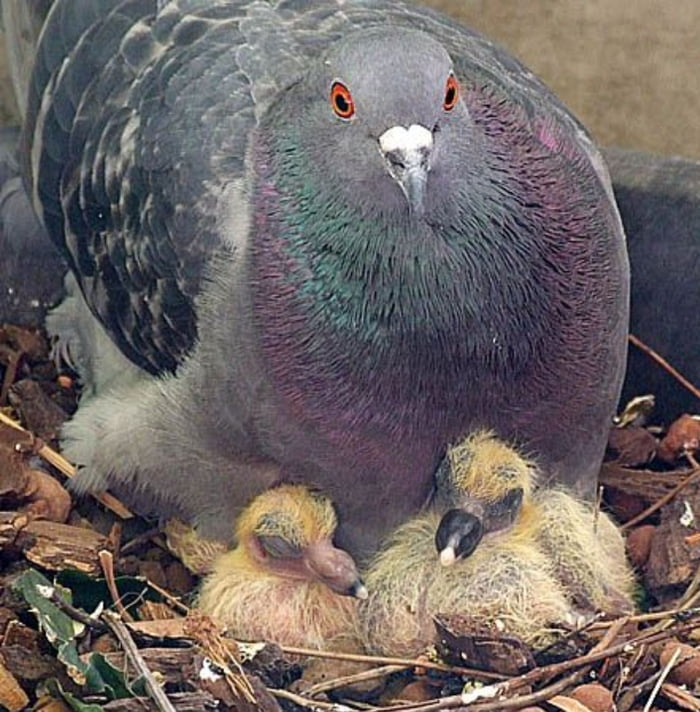
Making a bed that’s similar to the nest is great. A basket lined with a towel is an easy way to do this.
Be sure that there’s a solid base on the bottom to stabilizes the baby’s feet so they don’t splay, which can lead to feet problems as the pigeon gets older.
Never use things the baby might eat, such as sand or wood chips.
As the baby gets older, be sure that its bedding is wide and large enough to give it space to spread its wings so they can become strong and prepare it to leave the nest.
Sources:
- Comparing the Effect of Different Management and Rearing Systems on Pigeon Squab Welfare and Performance after the Loss of One or Both Parents.
how to get out at home if it fell out of the nest
Content
- 1 What does the pigeon chick eat
- 2 What to do if the pigeon chick fell out of the nest
- 3 How to feed the pigeon chick
- conditions
- 4.1 First week
- 4.
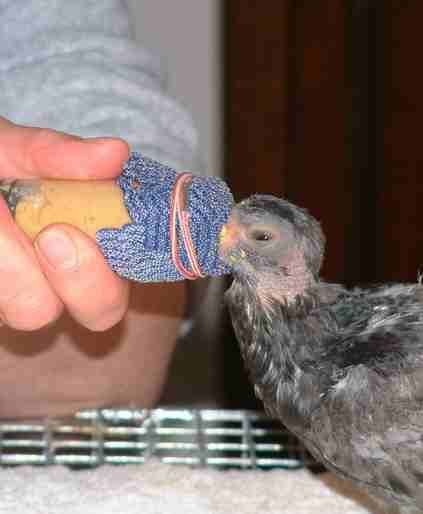 2 Second week
2 Second week - 4.3 Third week
- 4.4 Fourth week
- 4.5 After a month
- 50006
- 6 What to do if the pigeon chick does not eat
- 7 How to hatch the pigeon chick
- 8 Conclusion
Chicks, just like human children, need care and care from their mother. Often in life there are situations in which the chick is torn off from the mother's wing, for example, when he fell out of the nest. If necessary, a person can independently feed a feathered friend at home and, upon reaching the required age, release him into the wild. It is in such situations that it is necessary to know what pigeons feed their chicks, as a result of which there is a high probability of going out and raising a bird on their own.
What a pigeon chick eats
If a feathered bird is left without parents and was picked up by a human, then it should be properly fed and then sent to the wild when it reaches the required age. As practice shows, it is necessary to feed a pigeon chick from birth with crushed and well-brewed food. In the first days of life, a boiled egg yolk is perfect, which is injected into the feathered oral cavity through a syringe. In the future, it is worth feeding grains crushed to the state of flour and steamed in hot water. As the diet grows, it becomes much more diverse: fruits, vegetables, chopped greens, vitamins, live insects are introduced.
In the first days of life, a boiled egg yolk is perfect, which is injected into the feathered oral cavity through a syringe. In the future, it is worth feeding grains crushed to the state of flour and steamed in hot water. As the diet grows, it becomes much more diverse: fruits, vegetables, chopped greens, vitamins, live insects are introduced.
What to do if a pigeon chick has fallen out of the nest
In the event that a pigeon chick has fallen out of the nest, it is recommended to look around, suddenly its parents are nearby and are afraid to fly up to it because of the presence of people. If there are no adults nearby, then it is worth visually inspecting the pigeon chick itself. If there is plumage, it is completely dry, it behaves quite actively and is warm to the touch, then such a bird does not need help. Most likely this is his first flyby.
If the found pigeon chick does not fit this description and it is clear that without the help of a person it will die, then you should carefully take it without damaging the bones.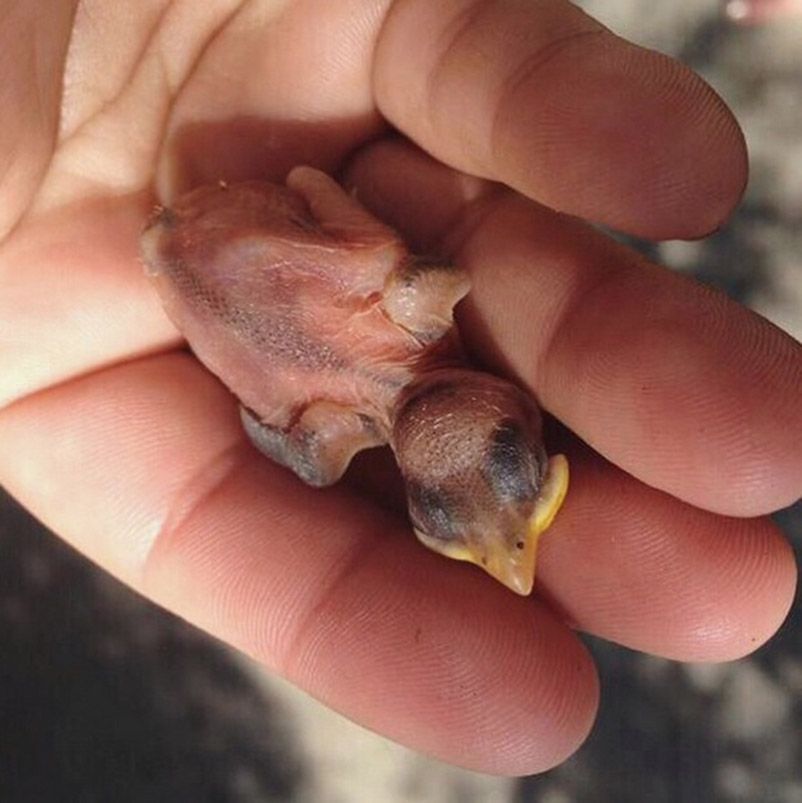 Take home to a warm place, starting the feeding process.
Take home to a warm place, starting the feeding process.
How to feed a pigeon chick
It is recommended to feed a pigeon chick strictly according to the age category. This is primarily due to the fact that if you give a week-old baby food intended for a pigeon chick aged 2-3 weeks, then the body simply will not be able to digest food and the pigeon will die. For feeding, you can use a syringe, nipple or pipette. Food is introduced into the oral cavity, making sure that the food completely fills the goiter. From the first days of life it is necessary to accustom to water.
How to feed a pigeon chick at home
Feeding a pigeon chick at home is not as difficult as it may seem to many at first glance. As practice shows, it often becomes necessary to independently feed those birds that were found, fell out of the nest and were left without maternal care. In order to understand exactly how to feed and care for pigeon chicks, it is necessary first of all to correctly determine their age - this is the only way to avoid causing even more harm.
In order to understand exactly how to feed and care for pigeon chicks, it is necessary first of all to correctly determine their age - this is the only way to avoid causing even more harm.
Approximate age can be determined by the following signs:
- rudimentary plumage appears on the 6-7th day of life;
- Eyes fully open on day 9;
- fully developed plumage can be seen by the end of 4 weeks;
- pigeons begin to show the first flitter rides at 6 weeks;
- the first molt occurs at 7 weeks;
- bird stops squeaking and starts cooing at 2-3 months of age;
- first sexual instincts appear at 5 months;
- final molt at 6 months.
If you correctly determine the age of a pigeon chick left without maternal care, then you can feed and leave the baby.
In the first week
If a newborn pigeon chick is in the hands, then in this case it is important not only to properly feed, but also to water. Thus, it is initially necessary to teach the feathered to take water and food. As practice shows, it is most difficult to get out birds that are about a week old, no more. This is due primarily to the fact that in the first 7 days of life, newborns need breast milk. In order to save the pigeon chick, you will have to make quite a lot of effort.
Thus, it is initially necessary to teach the feathered to take water and food. As practice shows, it is most difficult to get out birds that are about a week old, no more. This is due primarily to the fact that in the first 7 days of life, newborns need breast milk. In order to save the pigeon chick, you will have to make quite a lot of effort.
A step-by-step algorithm of actions that allows you to feed newborn birds is as follows:
- First of all, you need to purchase a 20 ml medical syringe from a pharmacy and carefully put a nipple on it, preferably a pipette.
- Egg yolk is perfect as a feed, as it contains a large amount of minerals so necessary for the normal life of a pigeon. You can also use special grains that are pre-ground to a state of flour.
- Received food is gently introduced into the oral cavity through a syringe, allowing time for the processing of the received components.
Pigeon chicks need to be fed at least 6 times throughout the day.
In the second week
Starting from the second week, it is recommended to introduce grain mass into the diet, as very soon the chick will start eating like an adult pigeon. It is worth feeding only grain crushed to the state of gruel and well steamed. This will require:
- Thoroughly grind the cereal through a coffee grinder several times.
- Mix the resulting flour with hot water.
- Let stand for 7 minutes.
It is important to understand that such a semi-liquid porridge is still incomplete food and cannot be fed. It is recommended to add chicken yolk to the steamed grain and only after that start feeding.
Since pigeon chicks require calcium for full growth and development, a solution based on calcium gluconate can be added to food. To improve the immune system, before you start feeding the chicks, add 2-3 drops of honey to the porridge.
By the end of the second week, the body of the chick will be completely covered with feathers, it will begin to move and scream even louder. During the day, birds are fed from 4 to 6 times. At the same time, it is worth making sure that the goiter is filled with food to the maximum.
During the day, birds are fed from 4 to 6 times. At the same time, it is worth making sure that the goiter is filled with food to the maximum.
Tip! If necessary, calcium gluconate can be replaced with crushed egg shells.
In the third week
From the third week, pigeon chicks feed completely differently. During this period of time, it is necessary to teach them to eat whole grains. Before feeding the birds, the grains should be placed in warm water for 10 minutes. In their natural habitat, parents give the chicks seeds of plants that have been in their stomach for some time and have undergone all the necessary processing, partially undergone splitting.
It is worth feeding with hands, young pigeons put no more than 3 grains into the mouth at each time. During this period of time, pigeon chicks begin to drink on their own. That is why, after they have already been fed (not before eating), you should carefully lower the baby's beak into a container of clean warm water.
Attention! It is important to ensure that liquid does not enter the chick's sinuses, as there is a high probability that it will choke.
Chopped greens and carrots can be gradually introduced into the diet.
In the fourth week
3 weeks after birth, pigeon chicks try to start eating on their own. During this period of time, they can be fed more varied. At this age, pigeons can be given a boiled and well-chopped chicken egg and a small amount of white bread. It is important to take into account the fact that only white can be fed, this is largely due to the fact that dark bread varieties have a coarser grinding and are less digestible by chicks.
It is recommended to sprinkle a small amount of grain on the table and lightly tap on the table top, thereby attracting the attention of pigeons. As practice shows, the chicks quite quickly understand what is required of them, and begin to eat food on their own.
Important! For a few more days, it is recommended to additionally feed the birds, giving food from the hands.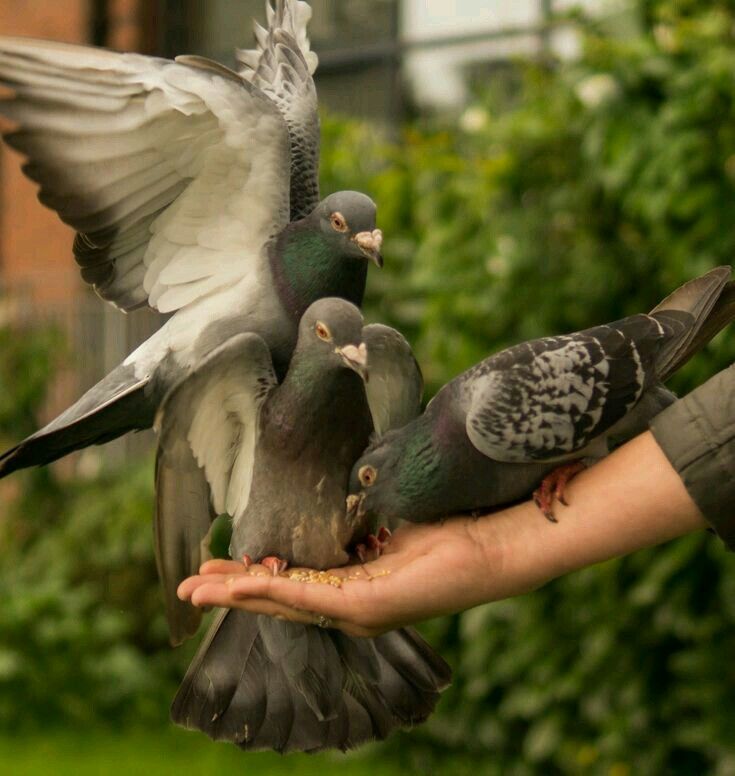
After a month
After a month, the diet can and even needs to be diversified. In such cases, it is necessary to feed with fruits, which are pre-cut into small pieces, give chopped greens. Small balls are made from the bread crumb, this is necessary so that the birds can independently take it in their beak and swallow it.
One month old chicks can be fed in the same way as adult pigeons. During this period of time, the babies are preparing for their first flight. Despite this, you should not quickly allow pigeons to adults, it is best to feed them separately for some time.
Tip! If the bird looks rather lethargic and eats little, then you need to add 3% glucose solution to the water.
What not to feed the chicks
Despite the fact that growing birds need insects, it is not recommended to feed them with the following:
- carcasses of insects of any kind. As practice shows, the death of an insect is a consequence of intoxication, and the poison also has a negative effect on the feathered body;
- Colorado beetles - they are not recommended because of their toxicity;
- ladybugs - capable of excreting a toxic liquid.
 Under natural conditions, if a bird has eaten a ladybug by mistake, then it immediately spits it out;
Under natural conditions, if a bird has eaten a ladybug by mistake, then it immediately spits it out; - hairy caterpillars - since such insects contain small hairs on the body, they can quite easily clog the crop;
- Brightly colored bugs - rich colors indicate that it is better not to risk using these insects.
In addition, meat and fish products should not be introduced into the diet, as it is quite difficult to process them.
Attention! It is best to feed the bird with nondescript bedbugs.
What to do if the pigeon chick is not eating
If it has been noticed that the pigeon chick is not eating, then special attention should be paid to the diet. It often happens that the age of the chick was determined incorrectly, respectively, and further feeding is carried out incorrectly. It is important to take into account the fact that at first adults feed babies with semi-digested food.
It is necessary to feed the bird with a syringe if it is still very small, larger individuals are fed by hand. It should be borne in mind that at first the chick will not be able to take food on its own, it must be helped in this matter. If necessary, you can add a 3% glucose solution to the water, which will help give strength.
It should be borne in mind that at first the chick will not be able to take food on its own, it must be helped in this matter. If necessary, you can add a 3% glucose solution to the water, which will help give strength.
How to hatch a pigeon chick
Caring for a pigeon chick must be of high quality and complete. It is important to understand that at first the plumage is completely absent, as a result, the chick may freeze. For these purposes, it is recommended to use a heating pad that will maintain the optimum temperature. When plumage appears on the dove, the heating pad can be removed, but it is necessary to ensure that the temperature regime does not fall below + 25 ° С.
Conclusion
Pigeons feed their chicks with semi-digested food. To do this, they use plant seeds that, while in the stomach of an adult, undergo primary processing and undergo partial splitting. This knowledge will help the chick come out on its own.
How to feed a pigeon chick at home, how many times and how?
Back
How to feed a pigeon chick?
- What do pigeon chicks eat?
- How to feed?
- First week
- Second week
- Third week
- Fourth week
- Feeding grown chicks
- How and what to drink?
- Chick care
- Can you feed a chick that has fallen out of the nest?
- Birds
- pigeons
- Keeping pigeons
- How to feed a baby pigeon?
191 likes
2 comments
Many pigeon breeders have experienced the situation where a chick needs to be hand-fed for some reason. This process is very complex and requires tremendous work and patience, however, it is possible to feed pigeons, and it is definitely worth trying.
This process is very complex and requires tremendous work and patience, however, it is possible to feed pigeons, and it is definitely worth trying.
ShowHide
- What do pigeon chicks eat?
- How to feed?
- First week
- Second week
- Third week
- Fourth week
- Feeding grown chicks
- How and what to drink?
- Chick care
- Is it possible to feed a chick that has fallen out of the nest?
What do pigeon chicks eat?
The diet of pigeons is varied. However, they will be able to eat most products only after 2 or even 3 weeks of life.
Pigeons eat:
- chicken yolks;
- millet;
- oats;
- barley;
- corn;
- peas;
- polished rice;
- wheat and millet;
- wiki.
How to feed?
Feeding birds at the age of 1-3 weeks is difficult, but nothing is impossible. You will have to be patient, because a person will have to teach the feathered self-feeding. The first week is the most difficult, but the next days of his life depend on how to care for him, how many times and what to feed him.
You will have to be patient, because a person will have to teach the feathered self-feeding. The first week is the most difficult, but the next days of his life depend on how to care for him, how many times and what to feed him.
Important! The main problem during this period is the refusal of the syringe from the chicks. You need to make every effort to teach your baby to eat that way. Otherwise, the bird will die within 20 hours.
First week
The first week of life will be decisive for the bird. A large part depends on human effort and perseverance, but the instinct for survival will also play a role.
Rules for feeding in the first days of life:
- For the first 7 days, the pigeon can eat only heated (important: not boiled) chicken yolk.
- It must be given through a large syringe (50-10 cc) with a rubber tip (small nipple) that has a small hole in it. You need to squeeze out the liquid gradually, bringing the nipple closer to the bird's beak.
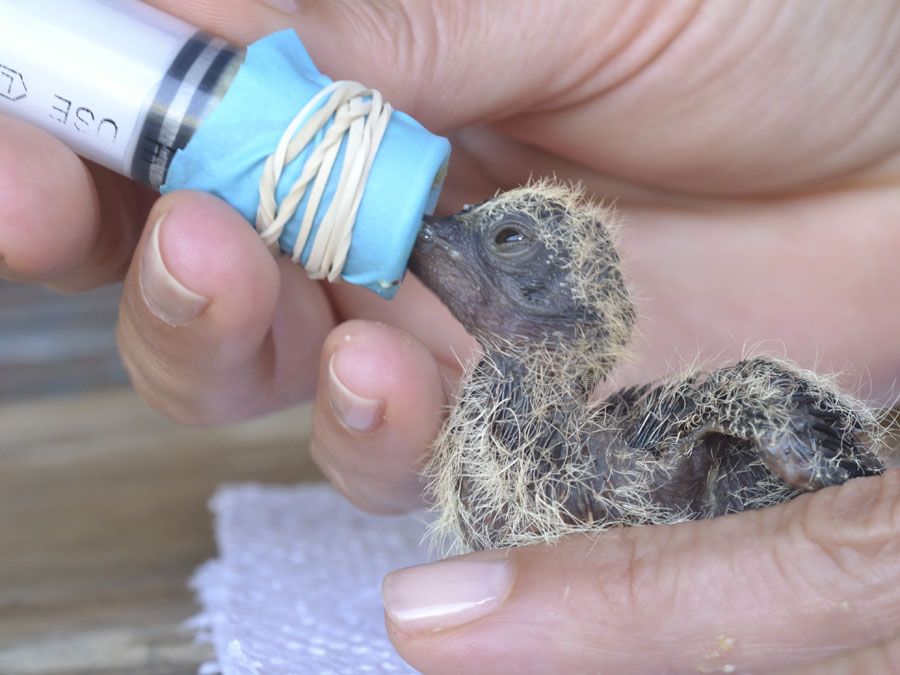
- Babies should be fed at least 6 times a day and given as much yolk as they are willing to eat.
Second week
The pigeons have already grown stronger, and the probability of their death has decreased. But during this period there are peculiarities in the nutrition of pigeons (for example, what kind of porridge to start feeding):
- After the 8th day of life, babies are fed with crushed steamed grains with ground eggshells. Such porridge will enrich the body with all the necessary "building" materials. You can add honey, and the bird will more readily use the mixture.
- Feed is already dispensed through a conventional large syringe.
- Meals are made at least 6 times a day until full.
Third week
Poultry must be switched to adult food, ie whole grains. Nursing babies during this period is especially interesting, because they have grown stronger and begin to show behavioral characteristics.
Feeding:
- Pigeons are transferred to whole steamed grain. If the grain becomes too large during the heat treatment, it must be divided in half. Once a day, you can give chopped greens.
- A bird at this age will not eat on its own, so it is necessary to put food in its beak.
- One feeding usually involves the birds eating 2-3 whole grains. The number of meals - 5-6 per day.
- During this period the pigeon is trained to drink water. To do this, it is necessary to dip the beak into the water (so that the liquid does not get into the sinuses). Immediately the chick will not drink, but after a few attempts, instincts will take their toll, and he will start drinking.
Fourth week
Pigeons begin to feed independently and varied.
Feeding after day 21:
- Carrots, fruits (not exotic), softened bread, boiled chicken eggs.
- Feed by syringe or small bottle until full 5-6 times a day.

- Pigeons, due to the increase in the diet, will begin to consume a lot of water. Clean water must be available at all times.
Important! In the third week of life, the pigeons' eyes open, and during this period it is necessary to come to them in the same clothes so that they can remember the person.
Feeding young chicks
Grown-up individuals completely switch to adult solid food (wheat, raw seeds, peas, corn). All cultures can be crushed a little and poured into the bird feeder, since it can already eat on its own. Cabbage, herbs, nettles are used as top dressing.
How and what to drink?
Pigeons should be fed with clean water of medium temperature. It is recommended to add vitamins to the water, which will help strengthen the body and immunity, which will be the prevention of diseases. To minimize the risk of infection, the bowl of water is kept clean and the water is changed before each drink. After the third week of life, clean water should be available around the clock.
After the third week of life, clean water should be available around the clock.
Chick care
Pigeon chicks are fragile creatures that are born blind, without plumage and the ability to move the first weeks of life, so they need special conditions for survival:
- The temperature should be high (+35-40 °C) because in the natural environment parents would warm the babies during this period.
- Complete absence of drafts. Weak individuals may not survive passing wind currents.
- Bedding should always be kept clean and dry as bacteria develop rapidly in bird droppings.
- The room must be constantly disinfected, drinkers and feeders should be washed several times a day.
- The dovecote must be protected from insects or animals.
Is it possible to feed a chick that has fallen out of the nest?
Feeding a chick that has fallen out of the nest is difficult and, most often, such cases are fatal for the bird. However, there are recommendations that will help you do everything to save a life:
However, there are recommendations that will help you do everything to save a life:
- Carefully pick up a fallen chick and carefully inspect its limbs for damage. If fractures are clearly visible, you can’t do without a veterinarian.
- If there are no visible injuries, the bird should be brought home as soon as possible and fed as described above. After that, you need to build a warm safe house for her.
- You need to constantly monitor the found baby, because every hour counts for him. But watching is not the same as worrying. The dove should remain at rest, and it is better for a person to watch him from the side.
- With proper feeding and good conditions, as well as with a high desire for life, a small bird will definitely get stronger and will be grateful to its savior.
